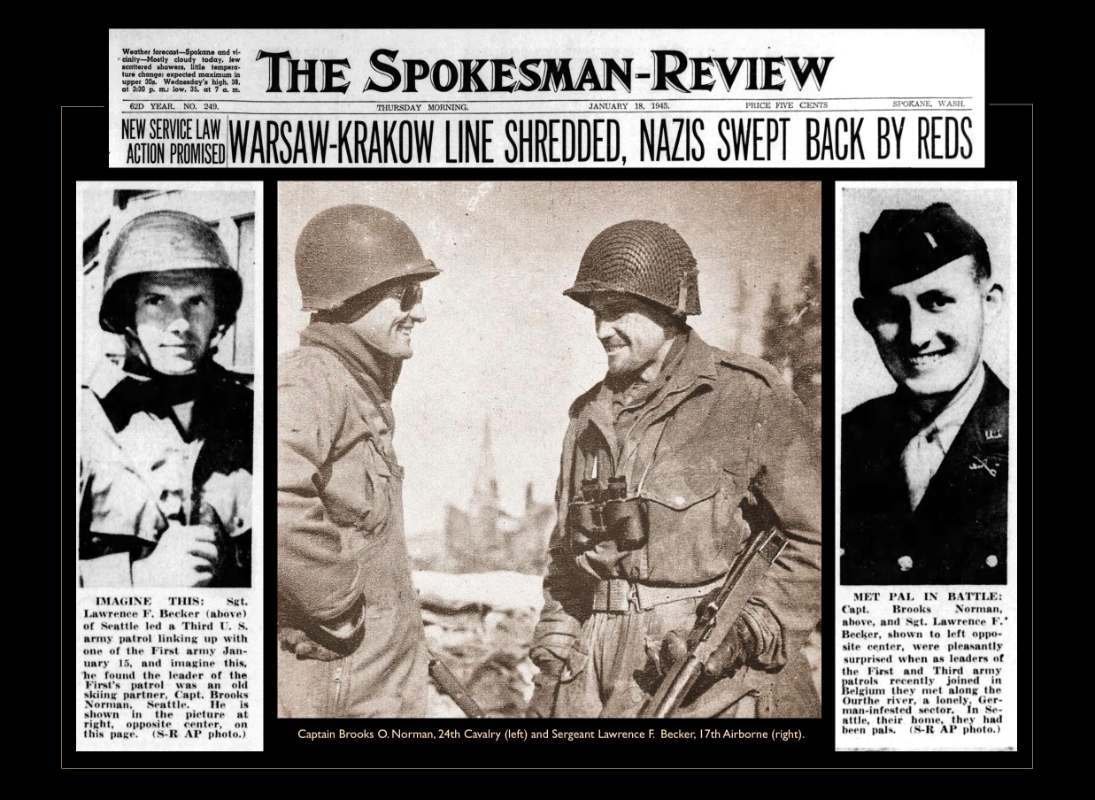This is a ‘beta’ release of the website, which remains a work in progress. Many links lead nowhere. It is best to check back frequently, if you are expecting to see specific information suggested
by a currently dead link title.
Captain Brooks Ogden Norman - commander of Troop A
Troop A of the 24th Cavalry Reconnaissance Squadron was led by Capt. Brooks Ogden Norman (service number 035793), a professional soldier who went on to serve in Korea and Vietnam, retiring as a Colonel in 1965.
In the video below we see Capt. Norman, seven months after passing through Normandy.
He is greeting Sgt. Lawrence F. Becker (service number 19096554), of the 507th Parachute Infantry Regiment, near the Ourthe river, at La Roche, in the Ardennes.
Capt. Norman was leading a patrol for the US First Army and Sgt. Becker was leading a patrol for the US Third Army when these scenes were captured on January 15th 1945.
This is one of the moments that represents the ending of the Battle of the Bulge.
According to news reports at the time the two men were amused to realise that they already knew each other, having been skiing partners before the war.
Note how Capt. Norman keeps his Thompson machine gun ‘jungle style’, with a second ammunition magazine taped to the active one. This was favoured by troops who were often in close combat, when it would save vital seconds otherwise pulling another magazine from a pouch.
The scenes are taken from a longer film found in the US National Archives https://catalog.archives.gov/id/23435
Captain Norman in the news, January 1945
Brooks Norman visited Normandy with his son Michael after the war, recounting some of his memories. One of his exploits almost ended his war prematurely, according to Michael. Capt. Norman and some comrades were determined to celebrate the 4th of July in 1944 and decided to stage their own ‘fireworks’ display, blowing up an abandoned pillbox with captured German munitions. They underestimated the power of the resulting explosion and were forced to take cover while concrete rained down on them. Fortunately no one was injured. This incident apparently led to a brief enquiry by the higher echelons of the 4th Cavalry Group, investigating a ‘mysterious explosion’ in Troop A’s sector but they were assured that it was also a mystery to Captain Norman.
On June 22 1944 Brooks was commanding Troop A when they came under attack by a company of German infantry in the small settlement of Gonneville (today known as Gonneville-Le Theil), near St Pierre Eglise. In this sustained firefight Brooks lost a friend, 2nd Lt. Joseph W. Gresham and personally retrieved his body.
Brooks was wounded during a patrol, on July 17, further south on the Cotentin peninsula. The After Action report for the period describes how he returned to his command post to brief comrades on the situation, before being evacuated for treatment.
Note confusion between the official record and this report in the Peninsula Daily News for January 17 1945 on his wounding in July 1944.
He was wounded again - more seriously - on July 29 somewhere near St Lô (on the same day that squadron commander Lt. Col. Fred Gaston Jr was also wounded and several others killed) and this time he was evacuated to Britain for treatment where he seems to have stayed for more than two months. During that hospital stay he wrote a moving letter to Joe Gresham’s mother, which you can see on Joe’s profile. We also have correspondence that Brooks Norman exchanged in connection with the D Day 50th anniversary commemorations in Normandy, which will appear in other sections of the site.
Brooks Norman was a key figure in the squadron, whose name appears particularly often during the fighting in Germany during March and April 1945, where he would often lead special fighting groups. ‘Task Force Norman’ would variously consist of Troop A and other sections from the 24th Cav Recon, along with attached units, such as sections of attached Tank Destroyer Battalions or Engineers. These missions will be detailed in due course as the site’s squadron timeline section is built.
Brooks Norman’s enlistment record
“He was kind of a wild guy - a real warrior.”
After the war, Brooks Norman wrote a paper detailing the work of the 24th Cav Recon’s sister unit, the 4th Cavalry Reconnaissance Squadron. It provides insight into the strengths, weaknesses, successes and pressures experienced by such units. It’s essential reading for anyone wishing to better appreciate the contribution of the 4th Cavalry Regiment and all the Mechanized Cavalry Groups that served in Europe during WW2. You can download the pdf here.
Brooks Ogden Norman was born June 17 1917, in Milwaukee, Wisconsin. He died February 27 2003, in El Dorado Hills, California, aged 85.





